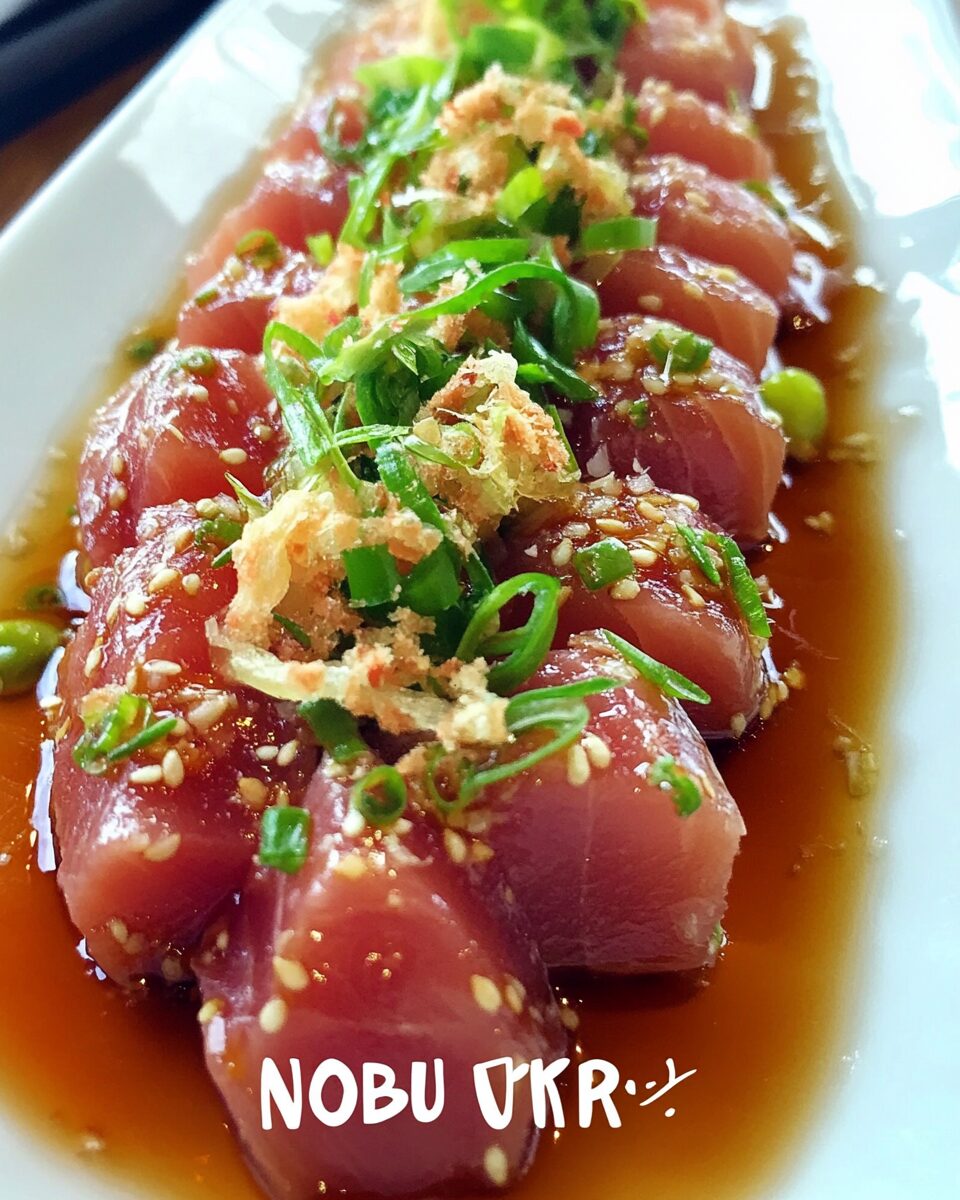Nobu-Style Tuna Tartare is a dish that combines simplicity with sophistication. The freshness of the sushi-grade ahi tuna is perfectly complemented by the citrusy brightness of lime, the umami depth of soy sauce, and the subtle heat of chili flakes. Every bite melts in your mouth, making it an irresistible appetizer for any seafood lover.
Whether served as a refined appetizer at a dinner party or as a light meal on a summer evening, this dish offers endless possibilities. Pair it with crispy wonton chips, avocado slices, or a side of seaweed salad for a complete gourmet experience. Its vibrant colors and delicate flavors make it a stunning addition to any table, impressing guests with both its taste and presentation.
Full Recipe:
- 1 pound sushi-grade fresh ahi tuna, finely diced
- 1 teaspoon freshly grated ginger root
- 2 tablespoons freshly squeezed lime juice
- 1 1/2 tablespoons tamari or soy sauce
- 1 1/2 tablespoons toasted sesame oil
- 1 teaspoon honey or agave syrup
- 1 teaspoon chili flakes (adjust to taste)
- 1 large scallion, thinly sliced (for topping)
- 1 tablespoon white sesame seeds (for garnish)
Directions:
- Dice the sushi-grade ahi tuna into small, uniform cubes.
- In a mixing bowl, whisk together the grated ginger, lime juice, tamari (or soy sauce), sesame oil, honey, and chili flakes. Adjust seasoning as needed.
- Gently fold the diced tuna into the dressing, ensuring it’s evenly coated. Let it marinate for 10 minutes to enhance flavor.
- Use a ring mold or spoon to shape the tartare on a plate, pressing gently to maintain structure.
- Garnish with thinly sliced scallions and white sesame seeds. Serve immediately for the freshest taste.
Prep Time: 10 minutes | Cooking Time: 0 minutes | Total Time: 10 minutes
Kcal: 104 kcal per serving | Servings: 8
Nobu-Style Tuna Tartare: A Culinary Masterpiece
Tuna tartare is a dish that embodies sophistication and simplicity, and when it comes to elevating flavors, few do it better than the world-renowned Nobu restaurant chain. Inspired by their iconic take on this raw delicacy, Nobu-Style Tuna Tartare is an exquisite blend of sushi-grade tuna, zesty citrus, savory umami notes, and a hint of heat. Whether you’re a seafood lover, an adventurous foodie, or simply looking for an elegant appetizer to impress your guests, this dish is a must-try.
The Origins of Tuna Tartare
Tuna tartare has deep roots in global cuisine, drawing influence from various culinary traditions. It is often associated with steak tartare, a classic French dish made from finely chopped raw beef, mixed with seasonings and served with egg yolk. The seafood variation, however, gained popularity in the late 20th century, especially in high-end Japanese restaurants that sought to highlight the delicate flavors of raw fish.
Chef Nobu Matsuhisa, the mastermind behind Nobu restaurants, played a significant role in popularizing tuna tartare as a fine dining staple. His unique blend of Japanese and Peruvian influences introduced bold flavors and innovative textures to the dish, making it an instant favorite among celebrities, food critics, and discerning diners worldwide.
Why This Recipe Stands Out
Unlike traditional tartare recipes that rely on a minimalist approach, Nobu-Style Tuna Tartare is an experience in flavor balancing. The combination of fresh lime juice, soy sauce, sesame oil, and a touch of sweetness from honey or agave syrup enhances the natural richness of the tuna. Meanwhile, a sprinkle of chili flakes adds a gentle heat, ensuring each bite delivers a depth of taste that lingers on the palate.
One of the key elements that sets this recipe apart is its emphasis on texture. The delicate cubes of tuna provide a buttery mouthfeel, while the garnishes—thinly sliced scallions and white sesame seeds—introduce a satisfying crunch. This contrast creates a harmonious interplay between softness and crispness, making every bite dynamic and unforgettable.
The Importance of Using High-Quality Ingredients
Because tuna tartare is a raw dish, ingredient quality is paramount. The main component, sushi-grade ahi tuna, must be exceptionally fresh. When selecting tuna, look for bright red flesh with a firm texture and no fishy odor. Sushi-grade tuna is flash-frozen at ultra-low temperatures to eliminate potential parasites, ensuring it is safe for raw consumption.
Beyond the fish, the supporting ingredients also contribute significantly to the final dish. Freshly squeezed lime juice adds brightness and acidity, while tamari or high-quality soy sauce delivers umami depth. Toasted sesame oil introduces a nutty aroma, and the honey or agave syrup provides a subtle sweetness that rounds out the flavors. By sourcing the best ingredients available, you enhance the authenticity and excellence of this dish.
How to Serve and Pair Nobu-Style Tuna Tartare
This dish is highly versatile and can be presented in various ways, depending on the occasion and personal preference. A classic plating method involves using a ring mold to create a neat, cylindrical shape on a chilled plate, ensuring an elegant and professional look. For a more rustic presentation, you can simply spoon the tartare onto a dish, allowing the natural beauty of the ingredients to shine.
Pairing tuna tartare with complementary side dishes and drinks further enhances the experience. Here are a few recommended pairings:
- Crispy Wonton Chips or Rice Crackers: These provide a crunchy contrast to the tender tuna and serve as the perfect vessel for scooping up the tartare.
- Avocado Slices: The creamy richness of avocado pairs beautifully with the light, citrusy flavors of the tartare, adding another layer of indulgence.
- Pickled Ginger: This acts as a palate cleanser between bites, ensuring that each taste of the tartare remains fresh and vibrant.
- Seaweed Salad: Offering an umami-packed and slightly tangy contrast, seaweed salad enhances the depth of the dish.
- White Wine or Sake: A chilled glass of crisp Sancerre, Sauvignon Blanc, or dry sake complements the delicate flavors of the tuna, elevating the dining experience.
Variations and Customization
One of the best aspects of tuna tartare is its adaptability. While the Nobu-Style version is already packed with layers of flavor, you can experiment with different ingredients to suit your taste. Here are a few variations to consider:
- Spicy Tuna Tartare: Add a spoonful of Sriracha or a drizzle of spicy mayo for extra heat.
- Truffle-Infused Tartare: Mix in a few drops of truffle oil for a luxurious twist.
- Citrus Burst: Replace lime juice with yuzu or grapefruit juice for a unique citrus profile.
- Tropical Touch: Add finely diced mango or pineapple for a sweet and tangy contrast.
- Herb-Infused: Incorporate finely chopped cilantro or Thai basil for an aromatic kick.
These small tweaks allow you to personalize the dish while maintaining its elegant and refined essence.
Tips for Success
Making Nobu-Style Tuna Tartare at home is simple, but a few expert tips can help you achieve restaurant-quality results:
- Use a Sharp Knife: A dull knife will crush the delicate tuna, affecting both texture and presentation. A sharp blade ensures clean cuts and even cubes.
- Work with Chilled Ingredients: Keep your tuna refrigerated until the last moment before preparation. Cold fish maintains its firmness, making it easier to dice and mix.
- Taste and Adjust: Before serving, take a small bite and adjust the seasoning as needed. Some may prefer more citrus, while others might enjoy a stronger umami kick.
- Don’t Overmix: Gently fold the dressing into the tuna to maintain its structure. Overmixing can lead to a mushy consistency, which takes away from the luxurious mouthfeel.
- Serve Immediately: Tuna tartare is best enjoyed fresh. If left sitting too long, the acidity in the lime juice will start to “cook” the fish, altering its texture.
Health Benefits of Tuna Tartare
Aside from being a culinary delight, Nobu-Style Tuna Tartare also offers numerous health benefits. Sushi-grade tuna is an excellent source of lean protein, which supports muscle growth and overall health. It is also rich in omega-3 fatty acids, known for their heart-healthy properties and ability to reduce inflammation.
Additionally, the ingredients in this dish—lime juice, ginger, sesame oil, and soy sauce—bring their own health-boosting elements. Lime juice provides vitamin C, ginger aids digestion and reduces nausea, sesame oil contains beneficial antioxidants, and soy sauce offers essential amino acids. Altogether, this dish is a nutrient-dense option that combines indulgence with wellness.
Conclusion
Nobu-Style Tuna Tartare is a true representation of balance—freshness, acidity, umami, spice, and texture all come together to create a dish that is both simple and sophisticated. Whether served as an elegant appetizer for a special occasion or enjoyed as a light, refreshing meal at home, it is a recipe that never fails to impress.
By focusing on high-quality ingredients, precise preparation, and thoughtful presentation, you can recreate the magic of Nobu’s famous dish in your own kitchen. With endless variations and pairing possibilities, tuna tartare remains a timeless favorite that celebrates the beauty of raw seafood in its purest form.





